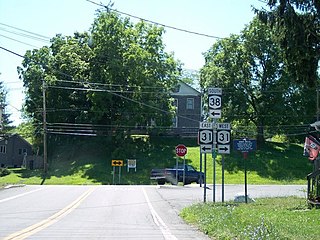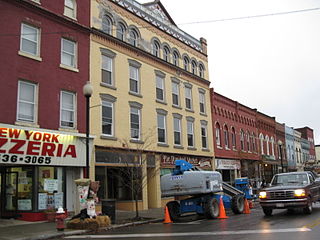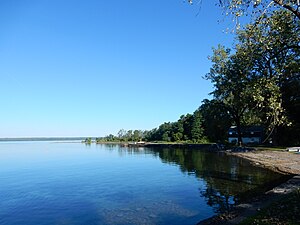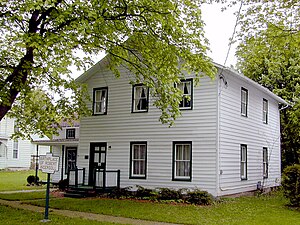
Conquest is a town in Cayuga County, New York, United States. The population was 1,796 at the 2020 census. The name was chosen to mark the victory of those who wished to form the town. Conquest is on the western border of Cayuga County and is west of Syracuse.

Mentz is a town in Cayuga County, New York, United States. The population was 2,114 at the 2020 census. The town is in the central part of the county, 7 miles north of Auburn.The town's name has never been determined, but it is locally believed that it derived from Mainz, in Germany.

Montezuma is a town in Cayuga County, New York, United States. The population was 1,277 at the 2010 census.
Port Byron is a village in Cayuga County, New York, United States. The population was 1,290 at the 2010 census. It is in the town of Mentz and is north of Auburn.
Millport is a village in Chemung County, New York, United States. The population was 312 at the 2010 census. The name comes from its former status as a canal port.
Burdett is a village in Schuyler County, New York, United States. The population was 357 at the 2000 census.
Catharine is a town in Schuyler County, New York, United States. The population was 1,656 at the 2020 census. The town is one of two in the county named after Catherine Montour, a Native American interpreter and leader in the area. The Town of Catharine is in the southeastern part of the county and is north of Elmira.
Montour is a town in Schuyler County, New York, United States. The population was 2,323 at the 2020 census. The town is one of two towns in the county named after Catherine Montour.
Pulteney is a town in Steuben County, New York, United States. The population was 1,260 at the 2020 census. The name is derived from the name of the original pioneer tract of land.
Urbana is a town in Steuben County, New York, United States. The population was 2,125 at the 2020 census.

Dundee is a village in Yates County, New York, United States. The population was 1,725 at the 2010 census. The name was taken from Dundee, the city in Scotland with a population of 148,260.

Jerusalem is a town in Yates County, New York. The population was 4,405 at the 2020 census. The town is named after the city of Jerusalem.

Milo is a town in Yates County, New York, United States. The population was 7,006 at the 2010 census. The town was named after Milo of Croton, a famous athlete from Ancient Greece.

Penn Yan is an incorporated village and the county seat of Yates County, New York, United States. The population was 5,159 at the 2010 census. It lies at the north end of the east branch of Keuka Lake, one of the Finger Lakes. Penn Yan, New York is home to one of the oldest mills in the United States, The Birkett Mills, founded in 1797.

Torrey is a town in Yates County, New York, United States. The population was 1,282 at the 2010 census. The name is taken from that of early county political leader Henry Torrey.
Lodi is a village in Seneca County, New York, United States. The population was 291 at the 2010 census.
Ovid is a village in Seneca County, New York, United States. The population was 602 at the 2010 census. The town was named by a clerk interested in the classics.
Ovid is a town in Seneca County, New York, United States. The population was 2,847 at the 2020 census. The town is named after the Roman poet Ovid, a name assigned by a clerk interested in the classics.

Seneca Falls is a hamlet and census-designated place in Seneca County, New York, United States. The population was 6,681 at the 2010 census. The 2020 census population of Seneca Falls CDP was 6,809. The hamlet is in the Town of Seneca Falls, east of Geneva. It was an incorporated village from 1831 to 2011.

Waterloo is a village and primary county seat of Seneca County, New York, United States. The population was 5,171 at the 2010 census and is now the most populated village in Seneca County. The village is named after Waterloo, Belgium, where Napoleon was defeated. It is the primary county seat of Seneca County, with the other being Ovid as part of a two-shire system established in 1822. Most of the county administrative offices are located in the village. Therefore, many political sources only list Waterloo as the county seat.


















